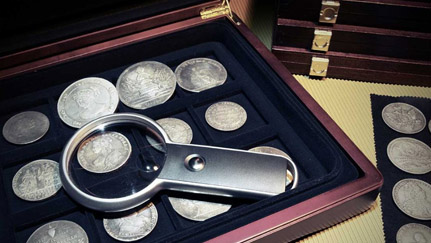
Investing in your treasured collection is a fun hobby. Spending Saturday afternoons combing the antique shops in pursuit of that next rare treasure can be endlessly satisfying. Anticipating the next big auction is almost as exciting as placing the winning bid.
If you’ve invested lots of time and money in a collection, you may have questions about the best ways to safeguard these prized possessions. In addition to purchasing the right insurance policy, you can take the following steps to protect your valuable collectibles.
Protecting against loss and preventing damage
The first step in protecting your collection is knowing what you actually have. This involves taking inventory of your collection. It’s important to keep a detailed list of your items, along with the purchase date, the price you paid, the market value and other data about each item, particularly if a loss occurs and you need to file an insurance claim.
Keep a detailed record of the items in your collection, and scan receipts and store them with your inventory lists to verify your investment and the items’ value.
Maintenance and cleaning
Do you collect metal items? Many of these can tarnish. However, some items can be more valuable because of their patina. You or a professional restorer can remove tarnishing if it’s undesirable. However, the removal process could potentially damage your items and reduce their value. Seek professional advice if you believe an item may require cleaning or repair.
Use archival-quality gloves when handling these and other valuables such as textiles and photographs. Gloves prevent the grime and oils on your skin from transferring to the item and possibly causing damage.1
Climate control
Humidity and exposure to extreme temperatures or sunlight could damage collections.2
Some materials — such as wood, paper, leather and some plastics — may incur permanent damage following exposure to humidity or sunlight.2 Humidity can also cause metal items to tarnish or corrode.2 Store them in climate-controlled spaces where there aren’t too many temperature fluctuations (your basement and attic may be off limits unless they’re well insulated). Limiting changes in temperature and humidity creates a stable environment.2
Avoiding direct sunlight can help protect collections. Artwork exposed to direct sunlight can fade and change color. Sunlight affects almost all media and can bleach it or cause it to crack.2 If you’re storing anything in a glass box, make sure it has a UV protective coating. Archival boxes are also ideal for limiting light penetration.3
Storage
Use containers or packaging with ventilation to avoid issues with trapped moisture and mold. Avoid plastic bags, which can hold moisture and lead to molding or rotting.2 Fireproof boxes are a good solution for paper collections such as photographs and comic books.
Properly pack delicate glass or ceramics in acid-free white paper before using bubble wrap or packing peanuts.4 These packing materials can damage some surfaces, so it’s important to put a protective layer between them and your collectibles.
Artwork
Rotating artwork on your walls is a way to keep your space interesting and fresh. But how do you store artwork when it isn’t being displayed in your home? One option is to find a professional company that can remove the art from your home, wrap it properly and store it securely off-site.
If you want to store art in your home, find a room in the interior area. Again, humidity and sunlight are art’s enemies. Consult a dealer to find out the best way to store your pieces; certain media require certain treatments. Store all artwork elevated off the ground in a room with little airflow to avoid dust and temperature changes.
Additional information on collection management and conservation is available through the Nationwide Private Client Risk Solutions Partner Network.
Coins5
Protect coins from the environment and from physical dings and scratches by storing them in individual hard-sided containers made from plastic. Avoid storing them loose together where they can rub on each other - this can wear down their surfaces and cause nicks and scratches. Other safe storage includes sleeves made from mylar or vinyl. Store coins in a dry area. Use a dehumidifier or silica gel packs to remove excess moisture from the air around the coins.
Clothing and textiles6
Designer and vintage clothing can last decades with proper care and storage. Consider using archival-style storage designed for couture clothing. When storing clothing in your home, avoid heat and high humidity levels. Different fabrics require different storage methods, so note that some textiles do better when stored flat. Clothing should be clean to avoid attracting pests. Use padded hangers when hanging clothes and choose acid-free clothing boxes for foldable items.7 You might also opt to keep these pieces with a wardrobe storage company. These facilities organize clothing and furs in climate-controlled spaces. You can easily swap things out seasonally or retrieve individual items to wear to events.
If you have any questions, please contact your agent or a Nationwide Private Client Risk Solutions professional.
[2] ”Restoring and preserving your collection,”collectorsweekly.com/answer-desk/restoring-and-preserving-your-collection (accessed Apr. 8, 2020).
[3] ”Archival Boxes,” lightimpressionsdirect.com/archival-boxes/ (accessed Apr. 8, 2020)
[4] ”Protect your treasures: Tips for packing your collection before a move,” bekins.com/2015/04/21/ (Apr. 21, 2015)
[5] ”Coin Collecting Tips — How to Store Your Coins,” Peter Mosiondz Jr, coinweek.com/coins/coin-collecting-strategies-2/tips-for-new-collectors/how-to-store-your-coins/ (Nov. 8, 2019)
[6] ”A Fashion Archivist Shares Her Tips For Storing Clothing,” Lisa Kocay, forbes.com/sites/lisakocay/2018/05/07/fashion-archivist-store-clothing-uovo/#756dc45a7960 (May 7, 2018)
[7] ”Textile storage — Stresses and hangups,” https://www.preservationequipment.com/Blog/Blog-Posts/Textile-storage-Stresses-and-Hangups (accessed Apr. 8, 2020)
This insurance overview is for informational purposes only and does not replace or modify the definitions and information contained in individual insurance policies, their endorsements or their declarations pages, which are controlling. Terms and availability vary by state and exclusions apply. Products are underwritten by Nationwide Mutual Insurance Company and affiliated companies, including Crestbrook Insurance, Columbus, Ohio. Nationwide, the Nationwide N and Eagle, Nationwide is on your side and Nationwide Private Client are service marks of Nationwide Mutual Insurance Company.